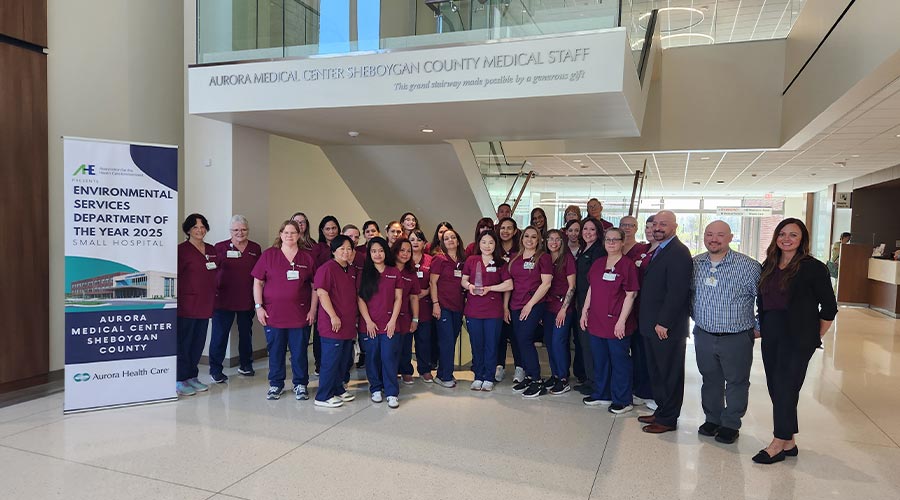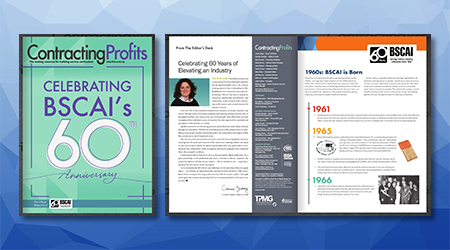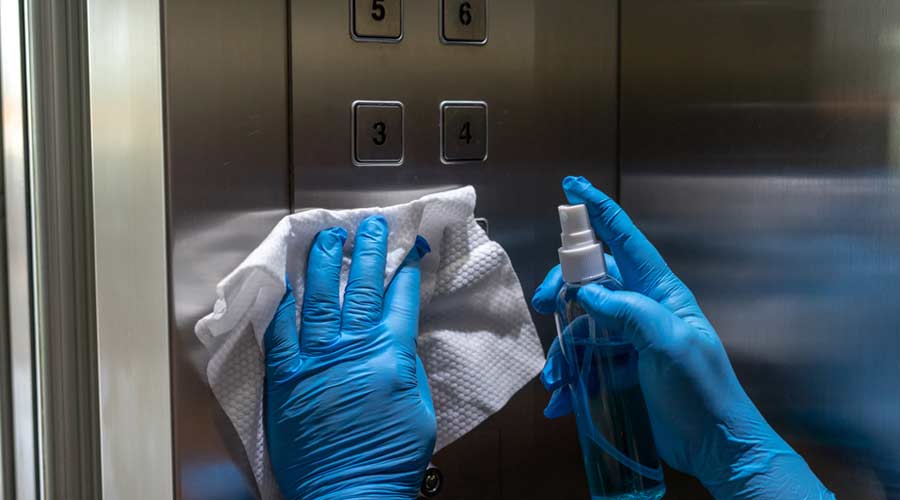
Awards make for a nice addition to any shelf, but more importantly, they’re often the result of a carefully executed plan. That’s exactly how Aurora Medical Center Sheboygan County (AMCSC) in Wisconsin ended up being recognized as a “2025 Environmental Services Department of the Year” by the Association for the Health Care Environment (AHE). The win directly stems from a deliberate and long-term strategy that’s been carefully designed to produce not just quality care and service, but award-winning results.
Facility cleaning managers looking to shore up their team morale would be well-served to take notice — lay the right foundation and set the bar high from day one and good things can happen. The result may include awards, but more importantly, everyone will benefit from a team that’s highly engaged and working efficiently.
The Environmental Services (EVS) leadership at AMCSC — comprised of Michael Clark, the former Environmental Services Manager; Jessi Moffatt, Environmental Services Supervisor; Amy Petrauski, Director of Environmental Services and Linen Distribution; and Jose Feliciano, System Vice President, Environmental Services, Patient Transport and Linen Distribution — are quick to emphasize that their success is no accident, or merely a stroke of good luck. In fact, for the leadership team, the end goal was chosen from the start. As they worked together to map out their team goals for the year, being the best EVS team sat atop the list. With everyone pulling in the same direction, the driving principles were clear: people, process, and purpose would steer the ship.
The goal stems from a philosophy that views the EVS role not as a mere job or series of tasks, but as a key aspect of patient care and, importantly, vital to the overall health of the facility. They also wanted to be the best. This outlook, combined with a commitment to solid execution, frees the team up to consistently achieve key metrics, from HCAHPS (Hospital Consumer Assessment of Healthcare Providers and Systems — a survey used to measure patient perceptions of the care they receive in healthcare settings) scores and patient throughput to employee retention and budget management. Their success story emphasizes a human-centric approach to leadership that addresses the role of EVS in a healthcare setting.
All Aboard
It's hard to dispute that the foundation of AMCSC’s success is its carefully designed onboarding and training program. For incoming frontline workers, the standard is set from the start with a process that begins before the employee even shows up for their first shift. The hiring process serves as a sort of training unto itself — providing the incoming worker with clarity about their work functions, role, and path forward within the company. Theoretically, there should be no surprises when they come through the door for the first time.
Jose Feliciano, the System Vice President, notes that the organization's engagement starts with welcome emails and cards, which helps new hires feel connected and prepared. Proactive communication can help cut down on "ghosting," a common challenge in the current labor market, and a problem that AMCSC has almost entirely eliminated.
Repeatedly, the leadership team emphasizes that a new employee’s first few weeks essentially serve as a first impression of the organization and can play a major role with regard to their long-term tenure. In an industry already inundated with high turnover, AMCSC set out to solidify employee retention via a finely planned four-week program that works to integrate a worker without inundating them.
"It can be very overwhelming, but we have things set up in a way that it's little pieces at a time, and it works really well," Jessi Moffatt, a supervisor on the team explains, highlighting the value of this detail-oriented approach. The team agrees, reiterating that a strong onboarding process is essential for all new staff, whether it be in a leadership position or on the frontline — everyone develops an understanding of the various roles that make the team work.
Once on board, new employees are taken through a comprehensive overview of the entire facility's cleaning processes. At AMCSC, the team may undergo some basic computer-based training and introductions, while more in-depth hands-on instruction with a veteran employee takes place on-site. This approach was specifically developed to help new staff understand both the "why" and the "how" of their role, and how it affects others — not just their immediate coworkers.
Michael Clark, who helped build the team from the ground up, says this initial training is crucial.
"We must show them our way, our standard way, as well as why it’s standardized the way it is," Clark explains. He notes that AMCSC will often adjust the training needs to the particular individual’s experience and learning style, leaving some room for flexibility.
While an experienced employee might learn how to properly clean a general area in a week, a more complex zone — like a surgery suite — might require two weeks. Making adjustments to meet the workers where they’re at pays dividends when it comes to fostering long-term employee engagement.
Beyond the initial onboarding, training is almost a rolling process for the entire EVS staff. This commitment to continuous learning helps ensure the entire team remains up-to-date on preferred best practices and organizational standards. The EVS staff themselves don’t often require specific certifications, says Amy Petrauski, but she notes that training modules — dealing with hazardous waste, for example — are tracked to ensure compliance.
EVS Leaders Focus on Teambuilding and Morale

 Celebrating BSCAI's 60th Anniversary eBook
Celebrating BSCAI's 60th Anniversary eBook The Down and Dirty on Cleaning in Virus Season
The Down and Dirty on Cleaning in Virus Season How Surfactant Use is Expanding in Commercial Cleaning
How Surfactant Use is Expanding in Commercial Cleaning